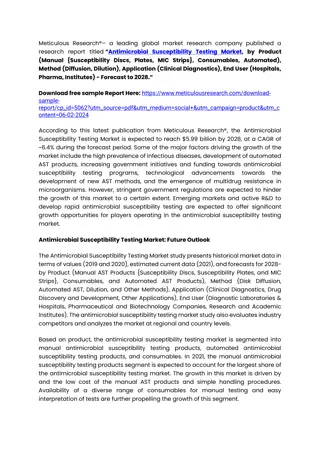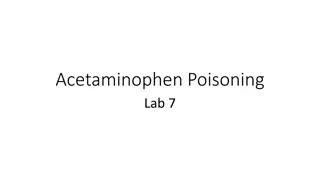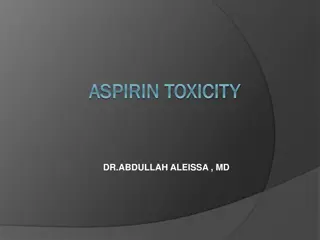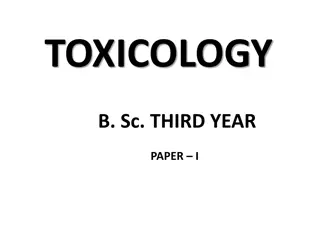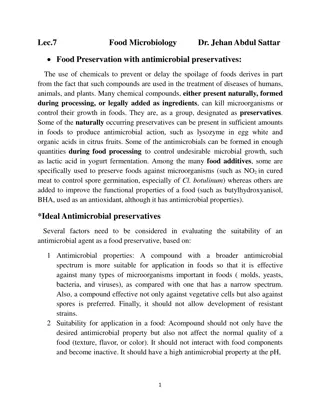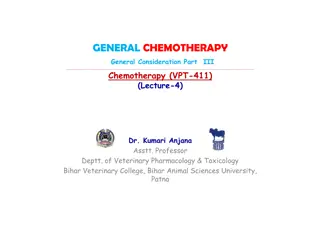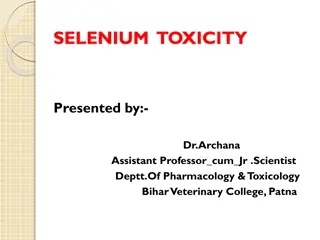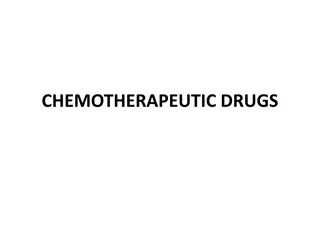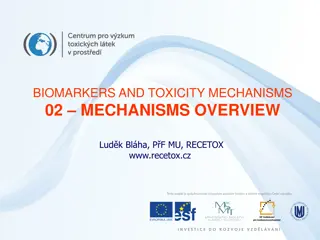Advances in Antimicrobial Drugs: Selective Toxicity and Classification
The development of antimicrobial drugs has significantly improved therapeutics by controlling infections and preventing complications. These drugs target invading microorganisms using selective toxicity, sparing host cells. Antimicrobial drugs are classified based on site, mechanism of action, and chemical structure. They include inhibitors of cell wall synthesis, protein synthesis, metabolism, nucleic acid, and cell membrane. Understanding the bactericidal and bacteriostatic effects of drugs is crucial in treating infections effectively. Bactericidal drugs are preferred for rapid microbiologic response and clinical improvement.
Download Presentation

Please find below an Image/Link to download the presentation.
The content on the website is provided AS IS for your information and personal use only. It may not be sold, licensed, or shared on other websites without obtaining consent from the author.If you encounter any issues during the download, it is possible that the publisher has removed the file from their server.
You are allowed to download the files provided on this website for personal or commercial use, subject to the condition that they are used lawfully. All files are the property of their respective owners.
The content on the website is provided AS IS for your information and personal use only. It may not be sold, licensed, or shared on other websites without obtaining consent from the author.
E N D
Presentation Transcript
The development of antimicrobial drugs represents one of the most important advances in therapeutics, both in the control or cure of serious infections and in the prevention and treatment of infectious complications of other therapeutic modalities such as cancer chemotherapy, immunosuppression, and surgery. Antimicrobial drugs have the ability to injure or kill an invading microorganism without harming the cells of the host taking the advantage of the biochemical differences that exist between microorganisms and human beings. In most instances, this selective toxicity toxicity is relative rather than absolute, requiring that the concentration of the drug be carefully controlled to attack the microorganism, while still being tolerated by the host. The antimicrobial drugs can be subclassified as antibacterial, antifungal, antiviral agents, and antiparasitic drugs. These agents include natural compounds, called antibiotics compounds. An antibiotic is a substance produced by one microbe that can inhibit the growth or viability of another microbe. selective antibiotics, as well as synthetic
Classification of Antimicrobial Drugs Classification of Antimicrobial Drugs Antimicrobial drugs are usually classified on the basis of their site and mechanism of action and are subclassified on the basis of their chemical structure. The antimicrobial drugs include cell wall synthesis inhibitors inhibitors, protein synthesis inhibitors protein synthesis inhibitors, metabolic and nucleic acid inhibitors nucleic acid inhibitors, and cell membrane inhibitors. cell wall synthesis metabolic and cell membrane inhibitors.
Antimicrobial Activity Antimicrobial Activity The antimicrobial activity of a drug can be characterized in terms of its bactericidal or bacteriostatic effect, its spectrum of activity against important groups of pathogens, and its concentration- and time- dependent effects on sensitive organisms. Bactericidal or Bacteriostatic Effect Bactericidal or Bacteriostatic Effect A bactericidal drug bactericidal drug kills sensitive organisms at serum levels achievable in the patient so that the number of viable organisms falls rapidly after exposure to the drug. In contrast, a bacteriostatic and replication of bacteria at serum levels achievable in the patient but does not kill them. For this reason, the number of bacteria remains relatively constant in the presence of a bacteriostatic drug, and immunologic mechanisms are required to eliminate organisms during treatment of an infection with this type of drug. (The same principle applies to a drug that kills or inhibits the growth of fungi and is referred to as a fungicidal drug fungicidal drug or a fungistatic fungistatic drug, bacteriostatic drug drug arrest the growth drug, respectively.)
A bactericidal drug is usually preferable to a bacteriostatic drug for the treatment of most bacterial infections. This is because bactericidal drugs typically produce a more rapid microbiologic response and more clinical improvement and are less likely to elicit microbial resistance. Bactericidal drugs have actions that induce lethal changes in microbial metabolism or block activities that are essential for microbial viability. For example, drugs that inhibit the synthesis of the bacterial cell wall (e.g., penicillins penicillins) prevent the formation of a structure that is required for the survival of bacteria. In contrast, bacteriostatic drugs usually inhibit a metabolic reaction metabolic reaction that is needed for bacterial growth but is not necessary for survival. For example, sulfonamides folic acid, which is a cofactor for enzymes that synthesize DNA components and amino acids. Most bacteriostatic agents are able to effectively kill organisms; however, they are unable to meet the arbitrary cutoff value in the bactericidal definition. Some drugs can be either bactericidal or bacteriostatic, depending on their concentration and the bacterial species against which they are used. For example, linezolid linezolid is bacteriostatic against Staphylococcus aureus and enterococci but is bactericidal against most strains of S. pneumoniae. inhibit a sulfonamides block the synthesis of
Antimicrobial Spectrum Antimicrobial Spectrum The spectrum of antimicrobial activity of a drug is the primary determinant of its clinical use. Antimicrobial agents that are active against a single species or a limited group of pathogens are called narrow narrow- - spectrum drugs spectrum drugs e.g., isoniazid isoniazid is active only against Mycobacterium tuberculosis Whereas agents that are active against a wide range of pathogens are called broad broad- -spectrum drugs spectrum drugs e.g., tetracycline fluoroquinolones fluoroquinolones and carbapenems carbapenems. Agents that have an intermediate range of activity are sometimes called extended spectrum drugs spectrum drugs e.g., ampicillin ampicillin. Narrow-spectrum drugs are sometimes preferred because they target a specific pathogen without disturbing the normal flora of the gut or respiratory tract. Broad-spectrum drugs are sometimes preferred for the initial treatment of an infection when the causative pathogen is not yet identified. tetracycline, extended- -
Concentration Concentration- - and Time Antimicrobial drugs exhibit various concentration- and time-dependent effects that influence their clinical efficacy, dosage, and frequency of administration. Examples of these effects are the minimal inhibitory concentration concentration (MIC) , the concentration concentration- -dependent killing rate Time Time- -dependent (concentration dependent (concentration- -independent) killing independent) killing and the postantibiotic postantibiotic effect effect (PAE). The MIC is the lowest concentration of a drug that inhibits bacterial growth after 24 hours of incubation. Based on the MIC, a particular strain of bacteria can be classified as susceptible or resistant or with intermediate sensitivity to a particular drug and is commonly used in practice to streamline therapy. The minimum bactericidal concentration (MBC) is the lowest concentration of antimicrobial agent that results in a 99.9% decline in colony count after overnight broth dilution incubations.It is rarely determined in clinical practice due to the time and labor requirements.] and Time- -Dependent Effects Dependent Effects minimal inhibitory dependent killing rate (CDKR),
An example of a CDKR: some aminoglycosides some fluoroquinolones fluoroquinolones (e.g., ciprofloxacin) show a significant increase in the rate of bacterial killing as the concentration of antibiotic increases from 4- to 64-fold the MIC of the drug for the infecting organism. Giving these drugs by a one dose per day achieves high peak levels, favoring rapid killing of the infecting pathogen. In contrast, - -lactams lactams, glycopeptides glycopeptides, macrolides linezolid linezolid effects are best predicted by the percentage of time that blood concentrations of a drug remain above the MIC. This effect is sometimes called time time- -dependent dependent (or concentration-independent) killing. For example, dosing schedules for the penicillins and cephalosporins that ensure blood levels greater than the MIC for 50% and 60% of the time, respectively, provide the most clinical efficacy. Therefore, frequent dosing , frequent dosing is important to achieve prolonged time above the MIC and kill more bacteria. After an antibacterial drug is removed from a bacterial culture, evidence of a persistent effect on bacterial growth may exist. This effect is the PAE PAE. Antimicrobial drugs that exhibit a long PAE are aminoglycosides and fluoroquinolones aminoglycosides (e.g., tobramycin) and macrolides, clindamycin clindamycin, and
Selection of Antimicrobial Agents Selection of Antimicrobial Agents Selection of the most appropriate antimicrobial agent requires knowing: 1) The organism s identity, 2) The organism s susceptibility to a particular agent, 3) Pharmacokinetic Properties, 4) Host factors, 5) Adverse Effect Profile, and 6) The cost of therapy. However, some patients require empiric therapy administration of drug(s) prior to bacterial identification and susceptibility testing). empiric therapy (immediate
A. Identification of the infecting organism A. Identification of the infecting organism Characterizing the organism is central to selection of the proper drug. A rapid assessment of the nature of the pathogen can sometimes be made on the basis of the Gram stain particularly useful in identifying the presence and morphologic features of microorganisms in body fluids that are normally sterile (blood, serum, cerebrospinal fluid [CSF], pleural fluid, synovial fluid, peritoneal fluid, and urine). However, it is generally necessary to culture the infective organism to arrive at a conclusive diagnosis and determine the susceptibility to antimicrobial agents. Thus, it is essential to obtain a sample culture of the organism prior to initiating treatment. Otherwise, it is impossible to differentiate whether a negative culture is due to the absence of organisms or is a result of antimicrobial effects of administered antibiotic. Definitive identification of the infecting organism may require other laboratory techniques, such as detection of microbial antigens, DNA, or RNA, or an inflammatory or host immune response to the microorganism. Gram stain, which is
Empiric therapy prior to identification of the organism Empiric therapy prior to identification of the organism The antimicrobial agent used to treat an infection is selected after the organism has been identified and its drug susceptibility established. However, in the critically ill patient, such a delay could prove fatal, and immediate empiric therapy is indicated. 1 1. Timing: . Timing: Acutely ill patients with infections of unknown origin for example, a neutropenic patient or a patient with meningitis require immediate treatment. If possible, therapy should be initiated after specimens for laboratory analysis have been obtained but before the results of the culture and sensitivity are available. 2 2. Selecting a drug: . Selecting a drug: Drug choice in the absence of susceptibility data is influenced by the site of infection and the patient s history (for example, previous infections, age, recent travel history, recent antimicrobial therapy, immune status, and whether the infection was hospital- or community-acquired). Broad therapy therapy may be indicated initially when the organism is unknown or poly- microbial infections are likely. The choice of agent(s) may also be guided by known association of particular organisms in a given clinical setting. For example, gram-positive cocci in the spinal fluid of a newborn infant is unlikely to be Streptococcus pneumoniae and most likely to be Streptococcus agalactiae (a group B streptococci), which is sensitive to penicillin G. By contrast, gram- positive cocci in the spinal fluid of a 40-year-old patient are most likely to be S. pneumoniae. This organism is frequently resistant to penicillin G and often requires treatment with a high-dose third- generation cephalosporin (such as ceftriaxone) or vancomycin. Broad- -spectrum spectrum
Determining antimicrobial susceptibility of infective Determining antimicrobial susceptibility of infective organisms organisms After a pathogen is cultured, its susceptibility to specific antibiotics serves as a guide in choosing antimicrobial therapy. Some pathogens, such as Streptococcus pyogenes and Neisseria meningitidis, usually have predictable susceptibility patterns to certain antibiotics. In contrast, most gram-negative bacilli, enterococci, and staphylococcal species often show unpredictable susceptibility patterns and require susceptibility testing to determine appropriate antimicrobial therapy. The minimum inhibitory and bactericidal concentrations of a drug can be experimentally determined.
Pharmacokinetic Properties Pharmacokinetic Properties The pharmacokinetic properties that influence antibiotic selection include oral bioavailability, peak serum concentration, distribution to particular sites of infection, routes of elimination, and elimination half-life. An ideal antimicrobial drug for patients would have good oral bioavailability and a long plasma half-life so that it would need to be taken only once a day. Azithromycin antibiotic that meets these criteria. The oral route of administration is appropriate for mild infections that can be treated on an outpatient basis. Parenteral administration is used for drugs that are poorly absorbed from the GI tract (such as vancomycin, and the aminoglycosides) and for treatment of patients with serious infections such as bacterial meningitis or endocarditis, for whom it is necessary to maintain higher serum concentrations of antimicrobial agents, for critically ill patients and for patients with nausea, vomiting, gastrectomy, ileus, or diseases that may impair oral absorption. The peak serum concentration of an antimicrobial drug should be several times greater than the MIC of the pathogenic organism for the drug to eliminate the organism. This is partly because the tissue concentrations of a drug are sometimes lower than the plasma concentration. The urine concentration of an antimicrobial drug can be 10 to 50 times the peak serum concentration. For this reason, infections of the urinary tract can be easier to treat than are infections at other sites. Azithromycin is an example of an
Sites of infection that are not readily penetrated by many antimicrobial drugs include the central nervous system, bone, prostate gland, and central nervous system, bone, prostate gland, and ocular tissues. ocular tissues. The treatment of meningitis requires that drugs achieve adequate concentrations in the cerebrospinal fluid. The penetration and concentration of an antibacterial agent in the CSF are particularly influenced by lipid solubility of the drug (lipid soluble drugs as chloramphenicol and metronidazole penetrate significantly whereas - lactam antibiotics, such as penicillin, are ionized and penetrate the blood-cerebrospinal fluid barrier only when the meninges are inflamed), molecular weight and protein binding of the drug. Because antimicrobial drug concentrations are low in bone, patients with osteomyelitis must usually be treated with antibiotics for several weeks to produce a cure. The prostate gland restricts the entry of some antimicrobial drugs because the drugs have difficulty crossing the prostatic epithelium and because prostatic fluid has a low pH. These characteristics favor the entry and accumulation of weak bases (e.g., trimethoprim) and tend to exclude the entry of weak acids (e.g., penicillin). The route of elimination affects both the selection and the use of antimicrobial drugs. Drugs that are eliminated by renal excretion (e.g., fluoroquinolones) are more effective for urinary tract infections than are drugs that are largely metabolized or undergo biliary excretion (e.g., erythromycin). Antibiotics that are eliminated by the kidneys (e.g., the aminoglycosides) can accumulate in patients whose renal function is compromised, so their dosage must be reduced in these patients.
Host Factors Host Factors Host factors that influence the choice of a drug include pregnancy, drug allergies, age and immune status, and the presence of renal impairment, hepatic insufficiency, circulation status, abscesses, or indwelling catheters and similar devices. Most antimicrobial drugs cross the placenta and can thereby affect the fetus. For example, administering tetracyclines to a woman during pregnancy pregnancy can cause permanent staining of her offspring s teeth. Penicillins and cephalosporins, however, cause very little fetal toxicity and can be safely administered to pregnant women who are not allergic to these drugs. Many individuals are allergic to one or more antimicrobial drugs. Penicillins are the most common cause of drug allergy. Renal or hepatic elimination processes are often poorly developed in newborns, making neonates particularly vulnerable to the toxic effects of chloramphenicol and sulfonamides. Young children should not be treated with tetracyclines or quinolones, which affect bone growth and joints, respectively. Decreased circulation to an anatomic area, such as the lower limbs of a diabetic patient, reduces the amount of antibiotic that reaches that site of infection, making it more difficult to treat.
The patients immune status the success of antimicrobial therapy. Advanced age, diabetes, cancer chemotherapy, cancer chemotherapy, and human immunodeficiency virus (HIV) human immunodeficiency virus (HIV) infection infection are among the more common causes of impaired immunity. Immunocompromised individuals should be treated with larger doses of bactericidal drugs and may require a longer duration of therapy than do immunocompetent individuals. Many antibiotics are excreted unchanged by the kidneys, and lower doses must be used if the patient has significant renal impairment. impairment. Less commonly, hepatic insufficiency hepatic insufficiency may require dosage adjustment for antimicrobial drugs that are extensively metabolized in the liver. Antibiotic access to an abscess abscess is poor, and the concentration of an antibiotic in an abscess is usually lower than in the surrounding tissue. Moreover, immune function is often impaired in an abscess. For these reasons, it is often necessary to surgically drain an abscess before the infection can be cured. Foreign bodies, Foreign bodies, such as indwelling catheters, indwelling catheters, provide sites where microbes can become covered with a glycocalyx coating (biofilm) that protects them from antibiotics and immunologic destruction. immune status is an important factor determining Advanced age, diabetes, renal
Adverse Effect Profile Adverse Effect Profile Even though antibiotics are selectively toxic to an invading organism, any antimicrobial drug can cause mild to severe adverse effects. Hypersensitivity or immune reactions to antimicrobial drugs or their metabolic products frequently occur. For example penicillin allergy. High serum levels of certain antibiotics may cause toxicity by directly affecting cellular processes in the host. For example, aminoglycosides can cause ototoxicity Superinfections Superinfections: : Drug therapy, particularly with broad- spectrum antimicrobials or combinations of agents, can lead to alterations of the normal microbial flora of the upper respiratory, oral, intestinal, and genitourinary tracts, permitting the overgrowth of opportunistic organisms, especially fungi or resistant bacteria. These infections usually require secondary treatments using specific anti-infective agents.
Microbial Sensitivity and Resistance Microbial Sensitivity and Resistance Laboratory Tests for Microbial Sensitivity Laboratory Tests for Microbial Sensitivity Microbial sensitivity to drugs can be determined by various means, including the broth dilution test, broth dilution test, the disk diffusion method (Kirby method (Kirby- -Bauer test), Bauer test), and the E E- -test method. Either the broth dilution test or the E-test method can be used to determine the MIC or MBC of a drug. On the basis of the MIC, the organism is classified as having susceptibility, intermediate sensitivity, intermediate sensitivity, or resistance resistance to the drug tested. These categories are based on the relationship between the MIC and the peak serum concentration of the drug after administration of typical doses. In general, the peak serum concentration of a drug should be 4 to 10 times greater than the MIC in order for a pathogen to be susceptible to a drug. Pathogens with intermediate sensitivity may respond to treatment with maximal doses of an antimicrobial agent. disk diffusion test method. susceptibility,
Microbial Resistance to Drugs Microbial Resistance to Drugs Nowadays, the antimicrobial agents are vastly overprescribed in outpatient settings. The availability of antimicrobial agents without prescription in many developing countries has by facilitating the development of resistance already severely limited therapeutic options in the treatment of life-threatening infections. Therefore, the clinician should first determine whether antimicrobial therapy is necessary for a given patient. Origin of Resistance Origin of Resistance Resistance can be innate or acquired. Acquired drug resistance arises from mutation and selection or from the transfer of plasmids that confer drug resistance. Mutation and Selection Mutation and Selection: : Microbes can spontaneously mutate to a form that is resistant to a particular antimicrobial drug. These mutations occur at a relatively constant rate, such as in 1 in 1012 organisms per unit of time. If the organisms are exposed to an antimicrobial drug during this time period, the sensitive organisms may be eradicated, enabling the resistant mutant to multiply and become the dominant strain.
The probability that mutation and selection of a resistant mutant will occur is increased during the exposure of an organism to suboptimal concentrations of an antibiotic, and it is also increased during prolonged exposure to an antibiotic. This observation has obvious implications for antimicrobial therapy. Laboratory tests should be used to guide the selection of an antimicrobial drug, and the dosage and duration of therapy should be adequate for the type of infection being treated. Whenever possible, the bacteriologic response to drug therapy should be verified by culturing samples of appropriate body fluids. Transferable Resistance: Transferable Resistance: Transferable resistance usually results from bacterial conjugation and the transfer of plasmids DNA) that confer drug resistance. Transferable resistance, however, can also be mediated by transformation transformation (uptake of naked DNA) or transduction transduction (transfer of bacterial DNA by a bacteriophage). Bacterial conjugation enables a bacterium to donate a plasmid containing genes that encode proteins responsible for resistance to an antibiotic. These genes are called resistance factors. resistance factors. The resistance factors can be transferred both within a particular species and between different species, so they often confer multidrug resistance. multidrug resistance. Studies have shown that resident microflora of the human body can serve as reservoirs for resistance genes, allowing the transfer of these genes to organisms that later invade and colonize the host. plasmids (extrachromosomal
Mechanisms of Resistance Mechanisms of Resistance The three primary mechanisms of microbial resistance to an antibiotic are (1) inactivation of the drug by microbial enzymes, (2) decreased accumulation of the drug by the microbe, and (3) reduced affinity of the target macromolecule for the drug. Inactivation Inactivation of the drug by enzymes is an important mechanism of resistance to -lactam antibiotics, including the penicillins. This form of resistance results from bacterial elaboration of - lactamase enzymes that destroy the - lactam ring. Resistance to aminoglycosides (e.g., gentamicin) is partly caused by the elaboration of drug-inactivating enzymes that acetylate, adenylate, or phosphorylate these antibiotics.
Decreased accumulation Decreased accumulation of an antibiotic can result from increased efflux efflux or decreased uptake decreased uptake of the drug. Both of these mechanisms contribute to the resistance of microbes to tetracyclines and fluoroquinolones. Increased drug efflux is often mediated by membrane proteins that transport antimicrobial drugs out of bacterial cells. Decreased uptake of antimicrobial drugs can result from altered bacterial porins porins. . Porins are membrane proteins containing channels through which drugs and other compounds enter bacteria. Resistance to penicillins by gram-negative bacilli is partly caused by altered porin channels that do not permit penicillin entry. increased Reduced affinity Reduced affinity of target molecules for antimicrobial drugs is a common mechanism of microbial resistance to most classes of antibiotics. This type of drug resistance often results from bacterial mutation followed by the selection of resistant mutants during exposure to an antimicrobial drug. For example, S. pneumoniae resistance to -lactam antibiotics involves alterations in one or more of the major bacterial penicillin-binding proteins, resulting in decreased binding of the antibiotic to its target.
Combination Drug Therapy Combination Drug Therapy It is therapeutically advisable to treat patients with a single agent that is most specific to the infecting organism. This strategy reduces the possibility superinfections, decreases the emergence of resistant organisms, and minimizes toxicity. However, some situations require combinations of antimicrobial drugs. For example, the treatment of mixed infections e.g. intra-abdominal abscess , life-threatening infections (to provide broad spectrum empiric therapy) and to decrease the emergence of resistant strains as in tuberculosis. When antimicrobial drugs are given in combination, they can exhibit antagonistic, additive, synergistic, or indifferent effects against a particular microbe. The relationship between two drugs and their combined effect is as follows: antagonistic antagonistic if the combined effect is less than the effect of either drug alone; additive equal to the sum of the independent effects; synergistic effect is greater than the sum of the independent effects; and indifferent if the combined effect is similar to the greatest effect produced by either drug alone. Some bacteriostatic drugs (e.g., chloramphenicol or tetracycline) are antagonistic to bactericidal drugs. Bactericidal drugs are usually more effective against rapidly dividing bacteria, and their effect may be reduced if bacterial growth is slowed by a bacteriostatic drug. additive if the combined effect is synergistic if the combined indifferent
If two bactericidal drugs that target different microbial functions are given in combination, they often exhibit additive or synergistic effects synergistic effects against susceptible bacteria. For example, penicillins, which are cell wall synthesis inhibitors, often show additive or synergistic effects with aminoglycosides, which inhibit protein synthesis, against gram-negative bacilli such as P. aeruginosa and against gram-positive enterococci and staphylococci. Likewise, sulfamethoxazole sulfamethoxazole and trimethoprim inhibit sequential steps in bacterial folate synthesis and have synergistic activity against organisms that may be resistant to either drug alone. Combination therapy may also serve to reduce the emergence of resistant organisms, such as in the treatment of tuberculosis. This is because about 1 in 106Mycobacterium tuberculosis organisms will mutate to a resistant form during treatment with any single drug. The rate of mutation to a form resistant to two drugs is the product of the individual drug resistance rates, or about 1 in 1012 organisms. Because fewer than 1012organisms are usually present in a patient with tuberculosis, it is unlikely that a resistant mutant will emerge during combination therapy. additive or trimethoprim


